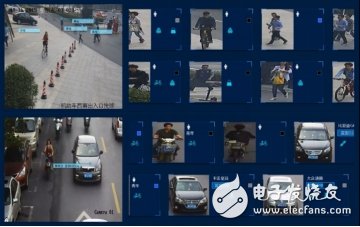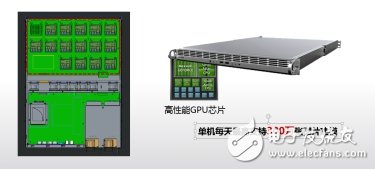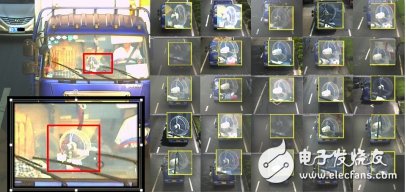Artificial intelligence (ArTIficial Intelligence, abbreviated AI) began in the mid-1950s, and then developed and fluctuated in the decades. In the late 1980s, with the rise of artificial neural network research, artificial intelligence entered a new stage. Especially in recent years, deep learning has made breakthroughs in artificial neural network optimization, making machine assistance possible and expanding the application field of artificial intelligence. In the field of security, with the continuous advancement of the construction of safe cities, more and more monitoring points, from the first few thousand roads, to tens of thousands of roads, and even to the scale of hundreds of thousands of roads now, the video and bayonet are massive. The data. At the same time, with the development of high-definition video, intelligent analysis, cloud computing and big data, security is moving from traditional passive defense to active judgment and early warning. The industry is also applying from a single security field to multiple industries. Production efficiency, improving the direction of life intelligence, providing more visual and intelligent solutions for more industries and people. With the development of the security field, the important role of artificial intelligence is gradually emerging. At present, users are faced with massive video data, and can no longer easily use human sea tactics for retrieval and analysis. Artificial intelligence is needed as an expert or assistant to analyze video content in real time, detect abnormal information, and conduct risk prediction. First, artificial intelligence technology Hikvision began to develop smart technology in 2006. After 10 years of accumulation, its intelligent technology has been used in all aspects of the product line, and as the goal of intelligent technology development - "artificial intelligence", we are determined The pursuit. Based on the present and looking to the future, we focus on the current research and development of artificial intelligence in video structuring technology and big data technology. 1. Video structuring technology Video structuring technology is the forefront of artificial intelligence technology that combines machine vision, image processing, pattern recognition, and deep learning. It is the cornerstone of video content understanding. Video structuring can be divided into three steps in the technical field: target detection, target tracking, and target attribute extraction. The target detection process extracts the foreground target from the video and then identifies whether the foreground target is a valid target (eg, person, vehicle, face, etc.) or an invalid target (eg, leaves, shadows, light, etc.). The target detection process is mainly applied to techniques such as moving target detection, face detection and vehicle detection. Hikvision Institute won the first place in the 2016 PASCAL VOC target test, which is the best embodiment of Hikvision's 10 years of research and development. The target tracking process is to achieve continuous tracking of a specific target in the scene, and obtain a high-quality image from the entire tracking process as a captured image of the target. In the target tracking process, it is mainly applied to multi-target tracking, target fusion and target scoring technology. Hikvision Institute won the "Multi-target Tracking Algorithm for Computer Vision" in the 2015 MOT Challenge algorithm evaluation. The target attribute extraction process is to identify the target attribute in the target picture that has been detected, and to determine which visual attribute attributes of the target have, such as gender, age, dress of the target, vehicle type, color of the vehicle target, and the like. The target attribute extraction process is mainly based on the feature extraction and classification techniques of the deep learning network structure. At the same time, in order to solve the high-performance analysis and calculation problem of video structure, we designed and developed the embedded GPU cluster server in 2015, making full use of the parallel processing capability of multi-GPU to improve the comprehensive performance of video structured processing. 2. Big data technology Big data technology provides powerful distributed computing power and knowledge base management capability for artificial intelligence. It is an important support for artificial intelligence analysis and prediction and independent improvement. It consists of three major components: massive data management, large-scale distributed computing, and data mining. Massive data management is used to collect and store all-round data resources involved in artificial intelligence applications, and to accumulate data based on the time axis, so as to reflect the laws of real things in the time dimension. At the same time, the huge knowledge base accumulated by artificial intelligence applications for a long time also needs to rely on the system for management and access. At present, the Haikang big data platform developed by Hikvision Research Institute has been able to support the management and application of 100 billion-scale vehicle traffic records. Large-scale distributed computing enables artificial intelligence to have powerful computing capabilities, analyze massive amounts of data at the same time, perform feature matching and model simulation, and provide personalized services for many users. Data mining is the core of artificial intelligence to achieve real value. It uses machine learning algorithms to automatically carry out multiple analysis and calculations, explore rules and abnormal points in data resources, assist users to find effective resources faster and more accurately, and conduct risk prediction and evaluation. . Second, artificial intelligence application At present, the rapid development of artificial intelligence technology has actively promoted the security field to move toward a more intelligent and humanized direction, mainly reflected in the following aspects: 1. Application in the public security industry The urgent need of users in the public security industry is to find clues to suspects in massive video information. Artificial intelligence has a natural advantage in feature extraction and content understanding of video content. The front camera has built-in artificial intelligence chip, which can analyze video content in real time, detect moving objects, identify people and vehicle attribute information, and transfer it to the central database of back-end artificial intelligence for storage. Aggregate massive city-level information, and then use powerful computing power and intelligent analysis capabilities. Artificial intelligence can analyze the suspect's information in real time, give the most likely clue suggestions, and lock the suspect's trajectory from the original few days. , shortened to a few minutes, saving valuable time for the detection of the case. Its powerful interactive ability can also communicate with the police in charge of the natural language, and truly become an expert assistant to the case handlers. Taking the vehicle characteristics as an example, the vehicle tracking can be performed by using a small electric fan in front of the driving position of the vehicle, and the trajectory of the suspected vehicle involved in the case is locked in a large amount of video resources. 2. Application in the transportation industry In the field of transportation, with the large-scale networking of traffic jams, the collection of mass vehicle traffic records information plays an important role in urban traffic management. Using artificial intelligence technology, real-time analysis of urban traffic flow, adjustment of traffic light intervals, and shortening of vehicle waiting Time to improve the efficiency of urban roads. The urban-level artificial intelligence brain can grasp the trajectory information of the passing vehicles on the city road, the vehicle information of the parking lot, and the parking information of the community in real time. It can predict the change of traffic flow and the number of parking spaces in advance for half an hour, and rationally allocate resources. It will divert traffic and realize large-scale traffic linkage dispatching at airports, railway stations, bus stations and business districts, improve the operational efficiency of the entire city, and provide guarantee for the smooth travel of residents. 3. Application in intelligent buildings In the field of intelligent buildings, artificial intelligence is the brain of the building, which comprehensively controls the security and energy consumption of the building, real-time tracking and positioning of people, vehicles and objects entering and leaving the building, distinguishing between office workers and outsiders, and monitoring the energy consumption of the building. It makes the building's operating efficiency optimal and extends the life of the building. The artificial intelligence core of the intelligent building summarizes the monitoring information and card records of the entire building. The indoor camera can clearly capture the personnel information, and compare the pass card information and the face information of the card reader in real time when the card is swiped, and detect the stolen card swiping behavior. It also distinguishes the trajectory and length of stay of the staff in the building, finds illegal visits and ensures the safety of the core area. 4. Application in the factory park Industrial robots have been around for a long time, but most are operational robots that are fixed on the production line. Mobile patrol robots will have broad application prospects in fully enclosed unmanned factories. In the factory park site, security cameras are mainly deployed at the entrances and exits and perimeters. The location of the inner corners cannot be covered. These places are precisely the corners of safety hazards. They use mobile patrol robots to regularly patrol and read instruments. Numerical values, analysis of potential risks, guarantee the reliable operation of fully enclosed unmanned factories, and truly promote the development of “Industry 4.0â€. 5. Application in civil security In the field of civil security, each user is highly personalized, using the powerful computing power and service capabilities of artificial intelligence to provide differentiated services for each user, enhance the security of individual users, and indeed meet the growing needs of people. service requirements. Taking family security as an example, when it is detected that there is no person in the family, the home security camera can automatically enter the arming mode. When there is an abnormality, the intruder is given an audible warning and the homeowner is notified remotely. When family members go home, they can automatically disarm and protect user privacy. During the night, through a certain period of self-learning, master the rules and regulations of family members, start the arming when the owner rests, ensure night safety, save the trouble of manual arming, and truly realize humanity. Third, the existing problems The application of artificial intelligence in the security field has very good prospects, but at present the domestic foundation is still weak, and there are still many problems in the application process that need to be improved and solved: 1) The quality of video imaging is greatly affected by the environment, such as insufficient illumination, blurred image, too small target size or mutual occlusion, which is not conducive to the identification of video content by artificial intelligence. 2) Data resources are scattered, open and shared to a low degree, and it is difficult to carry out multi-dimensional data fusion analysis, which makes artificial intelligence lack effective data support. 3) Insufficient accumulation of domain expertise. The early intelligent analysis technology belongs to single-scenario target detection and behavior analysis, and has weak understanding of video content. At the same time, it rarely involves the analysis of related behaviors of large-scale scenes. It does not accumulate effective empirical knowledge for abnormal analysis and risk. prediction. 4) Lack of effective self-improvement ability. At present, a lot of intelligence is just a kind of reactive intelligence, which is automatically judged according to the input conditions, and does not have the ability to grow. Artificial intelligence should have time-based experience accumulation and experience sharing ability among groups to continuously improve, making intelligent ability stronger and more efficient. to sum up Artificial intelligence is the future of security. On the road to the future, there are still many obstacles and difficulties that need to be overcome and overcome, but the overall trend is optimistic. We firmly believe that only human beings with independent, individualized and constantly evolving Intelligent brain can solve the increasing demand in the security field, become the experts and assistants of the majority of users, improve the intelligence level of the entire security field, and promote the upgrading of the security industry. 7 inch TFT LCD Industrial open frame Monitor,designed for industrial embeded applications.Its configuration of high-performance Resistive Touch Screen, especially suitable for industrial control, automation equipment, CNC machine tools, task management, and other environments. Users can use the OSD on the monitor display to easily adjust the image quality. LCD Monitor,LCD Open Frame,Embedded Open Frame,VESA mounting Tonya Display Limited , https://www.tydisplay.com


